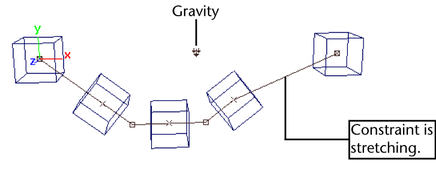When you use multiple constraints on several rigid bodies, you might create conflicting forces on the rigid bodies. The conflicting forces generate unexpected results. A conflicting force is a force applied perpendicular to constraints such that the correct solution would be for the constraints to stay exactly where they started.
For example, suppose you use a sequence of horizontally-aligned constraints and the end constraints are stationary (see the following figure).

If you apply gravity or if another rigid body collides with it, a perpendicular force is applied to the constraints. The constraints may stretch or wobble feebly.

To avoid this situation, delete the end constraints and recreate them so they are not perpendicular to the direction of the force.

 Except where otherwise noted, this work is licensed under a Creative Commons Attribution-NonCommercial-ShareAlike 3.0 Unported License
Except where otherwise noted, this work is licensed under a Creative Commons Attribution-NonCommercial-ShareAlike 3.0 Unported License